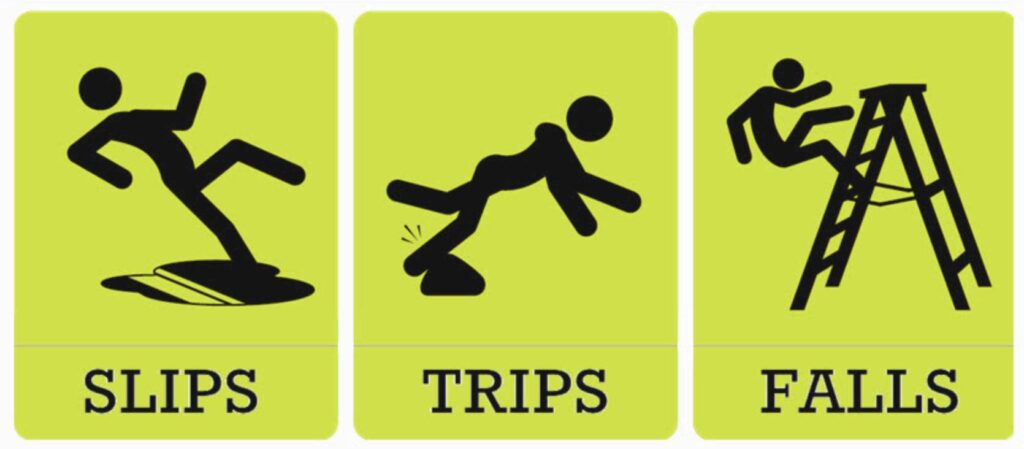Who is Responsible – How to Mitigate Risk
By: Alex Zhvanetskiy, Vice President of Samsonshield Inc.
Who hasn’t had a tumble or two but when it happens on your property, well, that may be a different story.
With winter upon us, this article is a very important read.
The media is littered with advertising for law firms that will represent people who have fallen on a property and the victims don’t have to pay anything until the case is settled. For a lot of people, this No Win – No Fee promise is a no-lose proposition. For insurance providers, property managers, condominium corporations and building owners, it’s always a lose-lose nightmare by way of time and money.
The Occupier’s Liability Act (OLA) has been in existence since 1990 in Ontario. Prior to that, Common Law was the prevailing law that governed the rights of those who slip, trip, tumble and fall and the obligations of property owners. The OLA defines who is considered an occupier and codifies the duty of care required by all occupiers to protect all attendees on their property.
Popularized by television and online commercials and because of the business practices of some law firms to withhold fees, insurance for multiplex residential buildings and commercial towers have increasingly and dramatically risen over the past decade due to increases in slip, trip and fall incident claims.
It is reported that there are over one million slip and fall injuries each year in the United States. It makes it the leading cause of injuries for all age groups, representing 12 per cent of all emergency room visits. The staggering medical bills exceed 34 billion dollars every year. With the average payout for a simple slip and fall being $30,000 to $50,000, this can have a big impact on budgets as most cases (98%) are settled out of court.
The urgency of condominium Boards and building owners to ensure that robust CCTV equipment covering all key areas of a property cannot be understated.
Unfortunately, countless lawsuits are remedied far too early because of a lack of objective and unequivocal evidence that CCTV cameras generally supply. Also, far too many cases are negatively affected by the lack of timely notification to an occupier who, when finally served with a civil action, try to secure CCTV evidence only to find that the footage had been over-written.
Changes to the OLA effective January 29, 2021, are very important to condominium Boards, property managers, and property owners. The time limit to notify an occupier of such tragedies has been narrowed to sixty days of the injury. It assists the industry greatly in that property managers and building owners can secure crucial evidence before it is irrevocably lost.

The test that the courts use is well defined. The OLA prescribes that occupiers must make all reasonable efforts and care to prevent injuries when people attend your property. There is also a duty of care that is expected by people who attend your property too; however, if there is no clear evidence by way of CCTV camera footage or eye-witness accounts to the contrary, it is always an uphill battle for the property owner or condominium corporation.
Most slip and fall incidents are preventable. There is no time like the present to ensure that your CCTV camera equipment covers all areas that may be of concern, including all outside sidewalks. You also want to make sure that recording devices extend well past ninety days to ensure essential evidence is secured in case it is needed. It is one of the highest priorities when Riskboss conducts site risk assessments.
Another essential risk mitigation strategy is training all on-site staff to recognize trip and fall hazards and immediately report such observations. Uneven stonework and walkway issues should be identified and mitigated right away. Signage in hazardous areas should be clearly visible. Lighting in hazardous areas should be full cut-off or partial cut-off lighting that clearly illuminates potential problems for pedestrians.
All snow removal and salting of sidewalks and pedestrian pathways should be clearly documented, recorded and kept in case it is needed. Also, snow removal companies should provide evidence that they are fully insured and submit WSIB Clearance Certificates to property managers. The OLA also covers their employees while they are on your property.
When slip, trip and fall incidents are reported in real time, it is critical to attend to the victim’s needs first and mitigate the risk of future incidents right away. Obtaining as much evidence as possible through CCTV footage, taking pictures of the incident site, and any injuries of and comments made by the victim(s) is also incredibly important. Reports should be as detailed as possible and completed as soon as possible as this is the best way to mitigate any damages.
